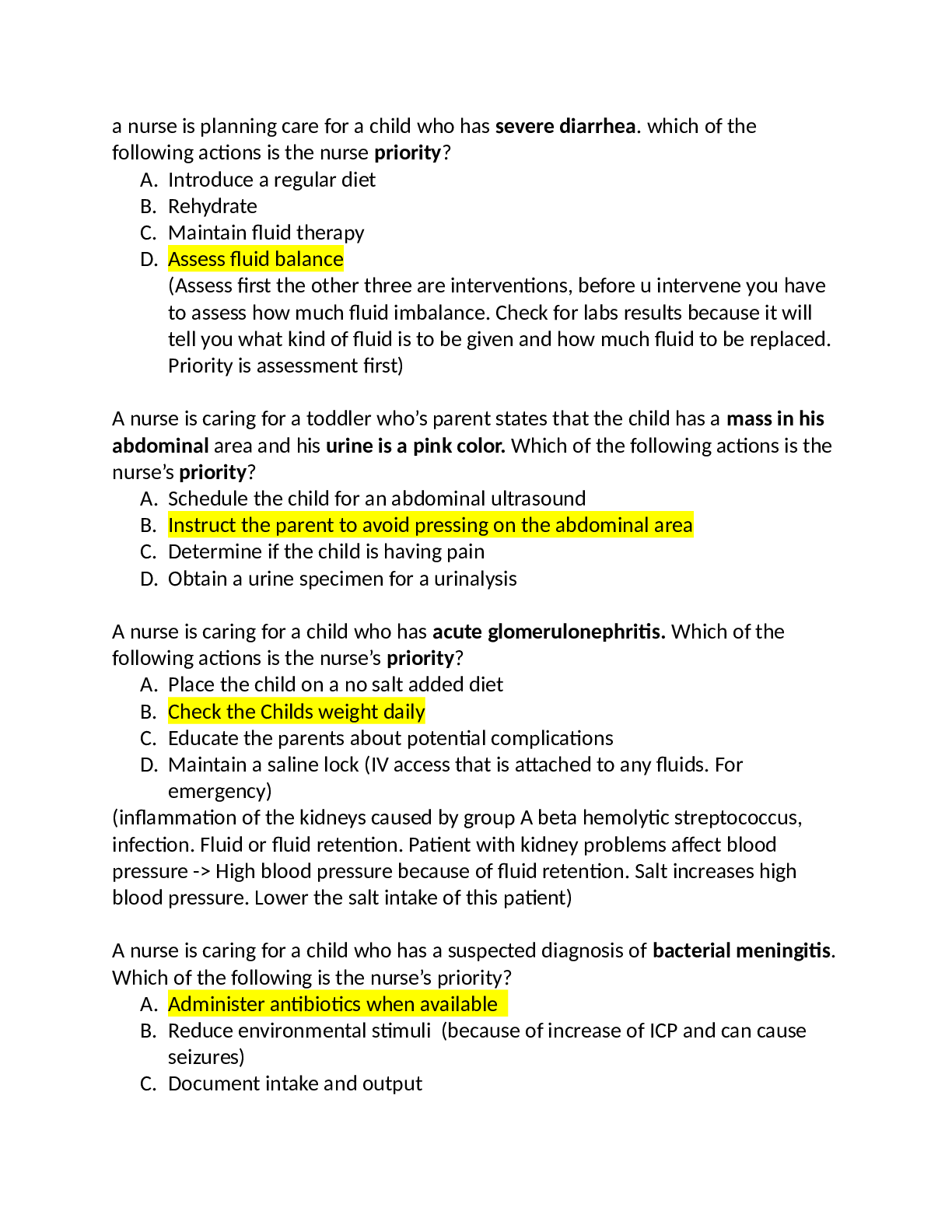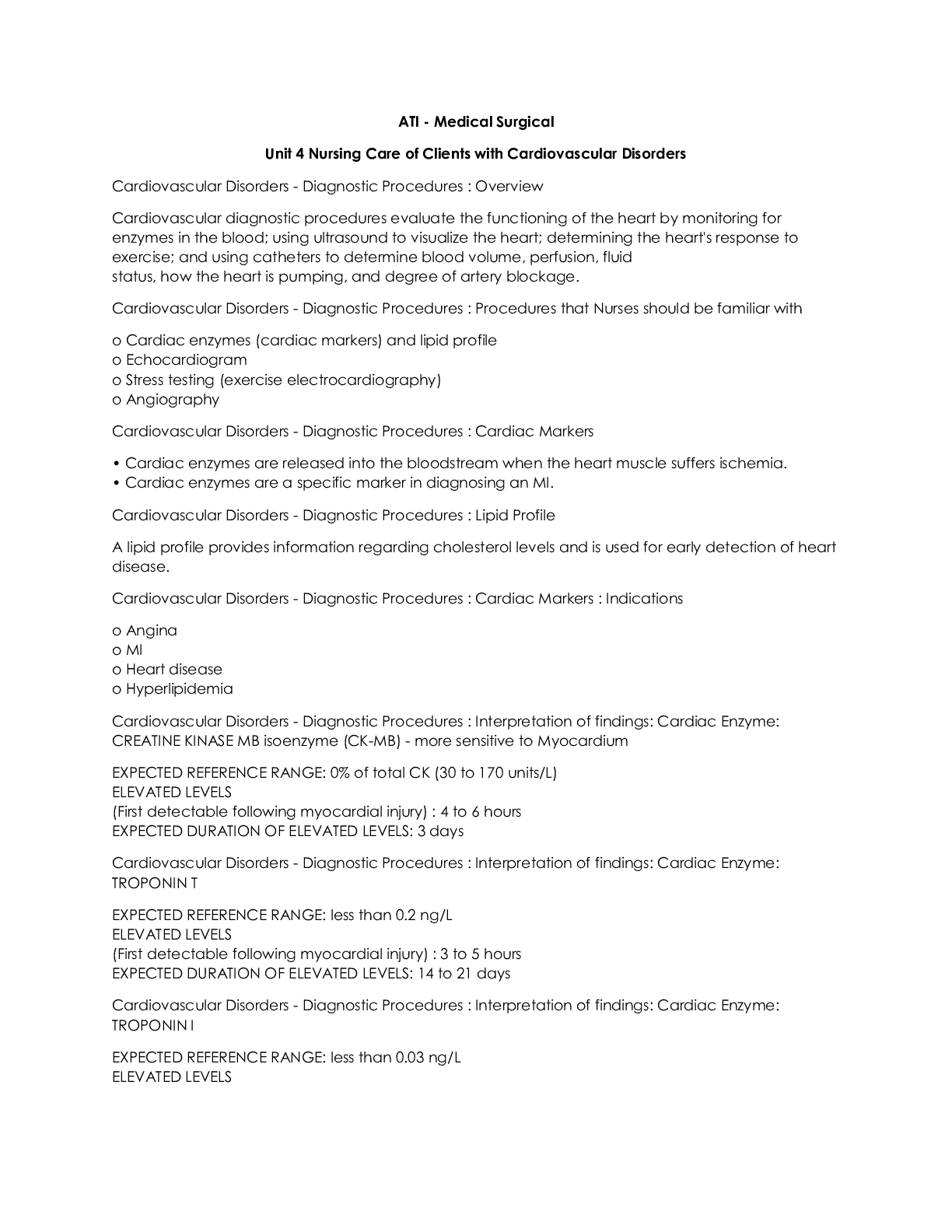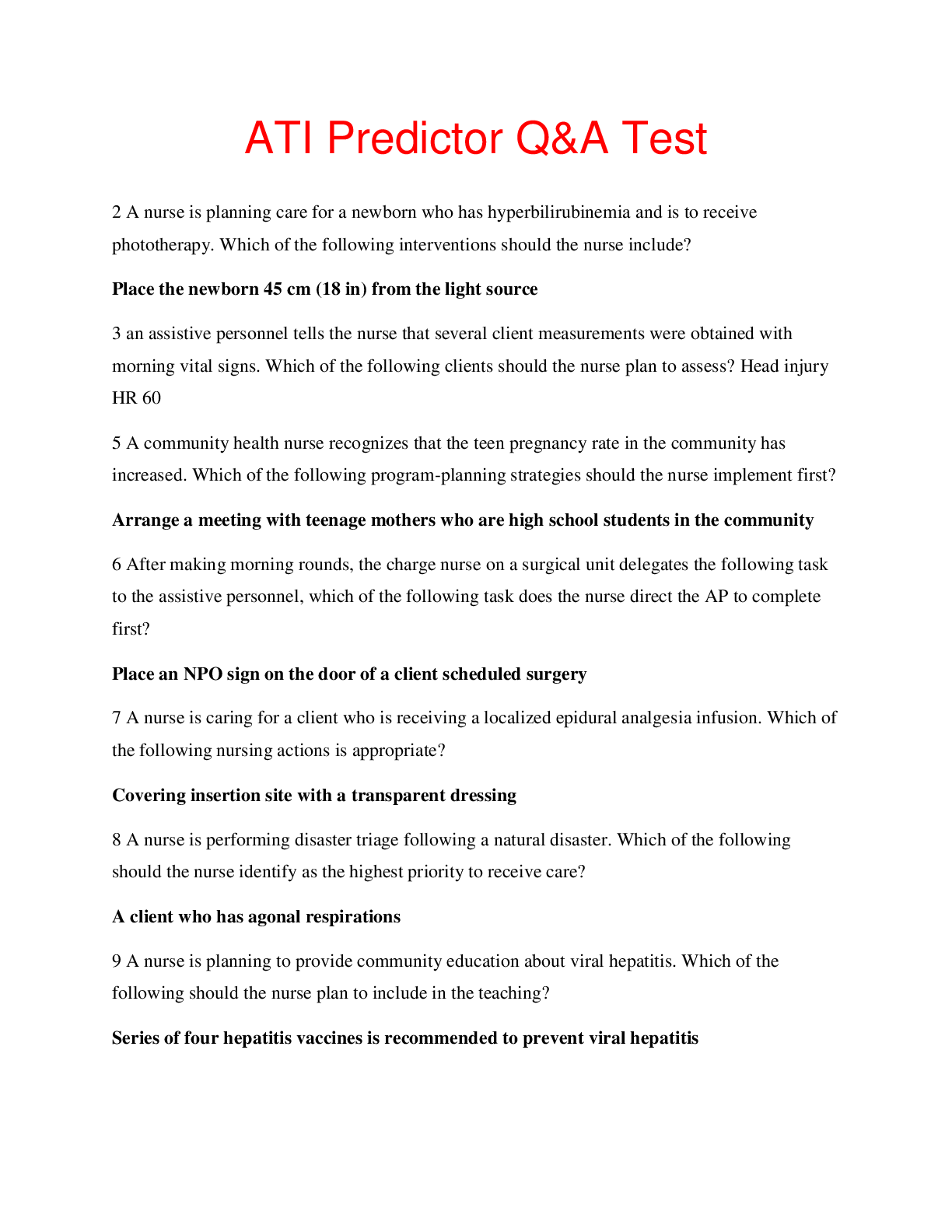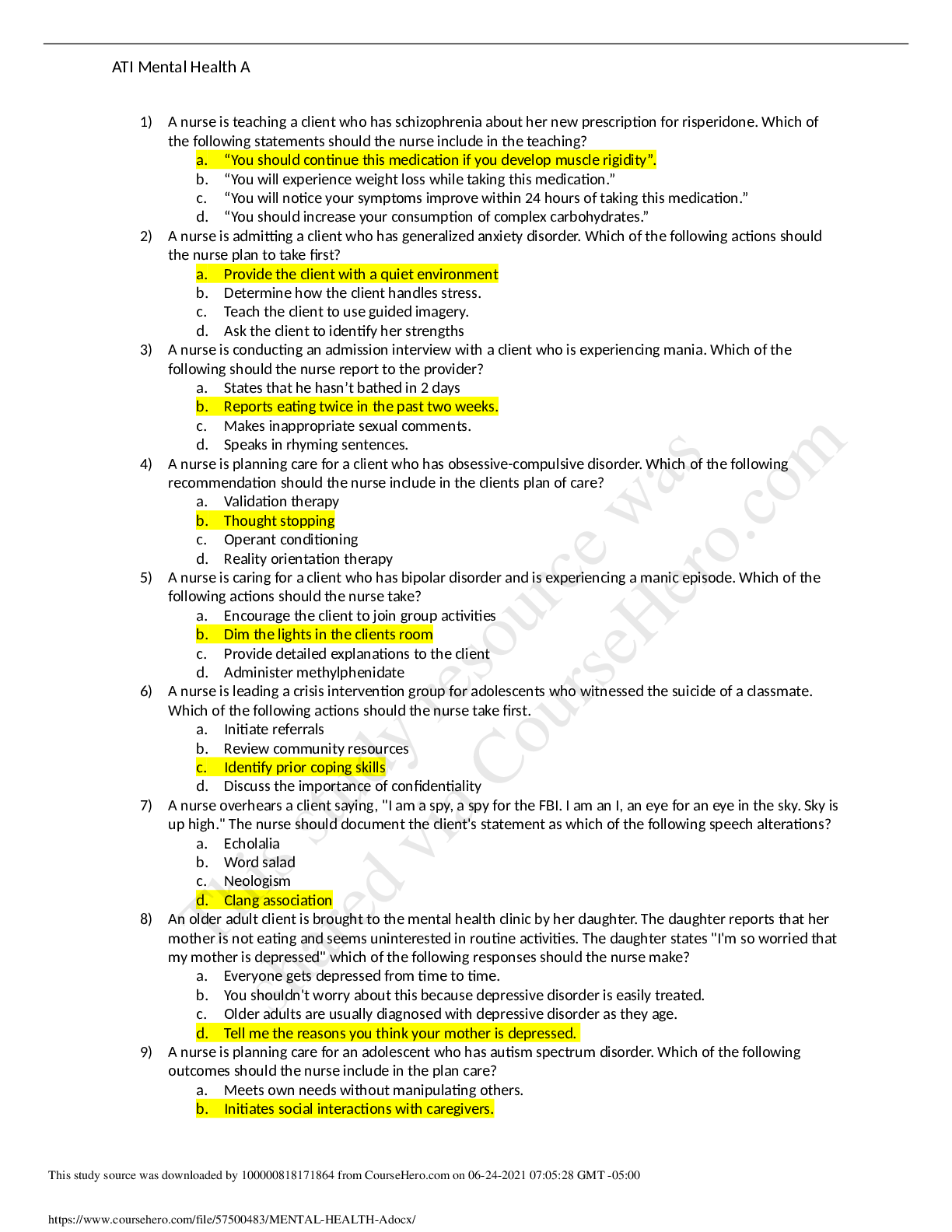*NURSING > QUESTIONS and ANSWERS > RN ATI pediatrics practice test A (70/70 Q&A) | Download To Score An A (All)
RN ATI pediatrics practice test A (70/70 Q&A) | Download To Score An A
Document Content and Description Below
1. 1st pic on phone (A- right lower quadrant) 2. A nurse is providing discharge teaching to the parents of a 3-month-old infant following a cheiloplasty. Which of the following instructions should ... the nurse include? apply a thin layer of antibiotic ointment on your baby's suture line daily for the next 3 days Rationale: apply for 3 days and continue apply petroleum jelly to the area for several weeks to promote healing 3. A charge nurse in an ED is preparing an in-service for a group of newly licensed nurses on the clinical manifestations of child maltreatment. Which of the following clinical manifestations should the charge nurse include as suggestive of potential physical abuse? Symmetric burns of the lower extremities Rationale: The nurse should include in the teaching that symmetric burns of the lower extremities are a suggestive clinical manifestation of physical abuse. The patterns are usually characteristic of the method or object used, such as cigar or cigarette burns, or burns in the shape of an iron. 4. A nurse is providing teaching to an adolescent about how to manage tinea pedis. Which of the following statements by the adolescent indicates an understanding of the teaching? wear sandals Rationale: Sandals allow air to circulate around the feet, decreasing perspiration and eliminating the medium for bacteria and fungus to grow. The nurse should inform the adolescent that wearing sandals, open-toed, or well-venillated shoes will promote healing of his fungal infection 5. A nurse is planning care for a toddler who has a serum lead level of 4. Which of the following actions should the nurse plan to take? schedule the toddler for a yearly rescreening & educate the family on ways to prevent exposure 6. Creating a plan of care for a newly-admitted adolescent who has bacterial meningitis. How long should the nurse plan to maintain the adolescent in droplet precautions? For 24 hr following initiation of antimicrobial therapy Rationale: The nurse should plan to maintain the adolescent on droplet precautions for at least 24 hr following initiation of antimicrobial therapy. This practice will ensure that the adolescent is no longer contagious, which protects family members and the personnel caring for the client. Prophylactic antibiotics might be prescribed to individuals who were in close contact with the adolescent. 7. A nurse is caring for a 15-year-old pt following a head injury. Which of the following findings should the nurse identify as an indication that the child is developing syndrome of inappropriate anitidiuretic hormone secretion (SIADH)? Mental confusion Rationale: A child who has a head injury can develop SIADH as a result of altered pituitary function, leading to an oversecretion of antidiuretic hormone. Oversecretion of antidiuretic hormone leads to a decrease in urine output, hyponatremia, and hypoosmolality due to overhydration. 8. A nurse is assessing the vital signs of a 10-year-old child following a burn injury. Clinical manifestation that indicate early septic shock? Temperature 39.1C (102.4F) Rationale: The nurse should expect a child who has early septic shock to have a fever and chills 9. A nurse is providing teaching about social development to the parents of a preschooler. Which of the following play activities should the nurse recommend for the child? Playing dress-up Rationale: The nurse should instruct the parents that at the preschool age, play should focus on social, mental, and physical development. Therefore, playing dress-up is a recommended play activity for this child. 10. A nurse in an ED is assessing a 3-month-old infant who has rotavirus and is experiencing acute vomiting and diarrhea. Manifestations that indicate moderate to severe dehydration? Sunken anterior fontanel Rationale: The nurse should recognize that a sunken anterior fontanel is an indication of moderate to severe dehydration due to the acute loss of fluid. 11. A school nurse is assessing a school-age child's BP while he is seated in a chair. The child starts to experience a tonic-clonic seizure. Appropriate action to take first? Assist the child to a side-lying position on the floor Rationale: The greatest risk to this child is aspiration, occlusion of the airway, and bodily injury from falling out of the chair. The nurse should ease the child down to floor in a side-lying position immediately. This position enables the child's secretions to drain from the mouth, preventing aspiration, and maintaining a patent airway. 12. a school nurse is assessing an adolescent who presents with multiple burns in various stages of healing. Which of the following behaviors should the nurse identify as suggestive of possible physical abuse? Denies discomfort during assessment of injuries Rationale: The nurse should suspect child maltreatment in the form of physical abuse idf rthe adolescent has a bluneted response to painful stimuli or injury 13. A nurse in a provider's office is caring for a school-age child who has varicella. The parent asks the nurse when her child will no longer be contagious. Appropriate response by the nurse? "When your child's lesions are crusted, 6 days after they appear." Rationale: The nurse should inform the parent that the child is contagious 1 day prior to lesion eruption and until the vesicles have crusted over, which usually takes about 6 days. 14. A nurse is providing dietary teaching to the parent of a school-age child who has cystic fibrosis. Appropriate statement to make? "You should offer your child high-protein meals and snacks throughout the day." Rationale: The parent should provide a diet that is well-balanced and high in protein and calories. Children who have cystic fibrosis require a higher percentage of the recommended dietary allowances of all nutrients in order to meet their energy requirements. Children who have good nutritional intake have improved lung function and decreased risk of infection. 15. A nurse is caring for a toddler who has spastic (pyramidal) cerebral palsy. Expected clinical manifestations? (select all) Negative Babinski reflex is incorrect. A child who has spastic cerebral palsy will exhibit a positive Babinski reflex. Ankle clonus is correct. A child who has spastic cerebral palsy will exhibit ankle clonus which is a rhythmic reflex tremor when the foot is dorsiflexed. Exaggerated stretch reflexes is correct. A child who has spastic cerebral palsy will exhibit spasticity or exaggerated stretch reflexes. Uncontrollable movements of the face is incorrect. Uncontrollable movements of the face and extremities are manifestations of nonspastic (dyskinetic) cerebral palsy, rather than spastic (pyramidal) cerebral palsy. Contractures is correct. A child who has spastic cerebral palsy will exhibit contractures due to the tightening of the muscles.Exaggerated stretch reflexes 16. A nurse is assessing an infant who has pneumonia. Which of the following findings is the priority for the nurse to report to MD? Nasal flaring Rationale: When using the airway, breathing, circulation approach to client care, the nurse should place the priority on nasal flaring. Nasal flaring indicates that the infant is experiencing acute respiratory distress. *The nurse should report a WBC of 11,300/mm^3 bc it is above expected range and indicates infection. However, another finding is the priorty. 17. A nurse is providing teaching to the parents of a preschooler who has heart failure and who is beginning to take digoxin twice daily. Appropriate instructions to include? "Brush the child's teeth after giving the medication." Rationale: The nurse should instruct the parents to brush the child's teeth after administering digoxin to prevent tooth decay caused by the medication, which comes as a sweetened liquid to enhance the taste. 18. A nurse is assessing a 3-yo toddler at a well-child visit. Which of the following manifestations should the nurse report to the MD? Respiratory rate 45/min Rationale: A respiratory rate of 45/min is above the expected reference range for a 3-year-old toddler and can indicate respiratory dysfunction and acute respiratory distress. Therefore, the nurse should report this finding to the provider immediately. • BP of 90/50mmHg is expected reference range for 3-year old • Weight of 14.5kg (32lbs) is within expected reference range for 3-year-old • Heart rate of 110/min is within expected reference range for a 3-year old toddler 19. A nurse is reviewing the lab report of a school-age child who is experiencing fatigue. Which of the following findings should the nurse recognize as an indication of anemia? Hematocrit 28% Rationale: The nurse should recognize that this hematocrit level is below the expected reference range for a school-age child. The child can exhibit fatigue, lightheadedness, tachycardia, dyspnea, and pallor due to the decreased oxygen-carrying capacity. NORMAL: • Hemoglobin 13.5 g/dL • WBC 8,000 mm^3 • Platelet 250,000 mm^3 20. A nurse is providing discharge teaching to the parent of a school-age child who has moderate persistent asthma. Which of the following instructions should the nurse include? "Pulmonary function tests will be performed every 12-24 months to evaluate how your child is responding to therapy." Rationale: The nurse should inform the parent that her child will need pulmonary function tests every 12 to 24 months to evaluate the presence of lung disease and how the child is responding to the current treatment regimen. As children grow, sometimes their symptoms can improve or decline and treatment needs to change accordingly. 21. A nurse is caring for a preschooler who is scheduled for hydrotherapy tx for wound debridement following a burn injury. Appropriate action to take prior to the procedure? Administer an analgesic to the child. Rationale: Hydrotherapy for debridement of a wound is an extremely painful procedure which requires analgesia and/or sedation. When pain is controlled, it leads to reduced physiological demands on the body caused by stress and decreases the likelihood of children developing depression and post-traumatic stress disorder. 22. A nurse is providing teaching to the family of a school-age child who has juvenile idiopathic arthritis. Instructions to be included in the teaching? "Encourage the child to perform independent self-care" Rationale: The nurse should teach the family the importance of encouraging the child to perform independent self-care. This will minimize the child's pain while maximizing mobility. Encouraging and praising the child's efforts for independence will also increase his self-esteem. *they should sleep on firm mattress, large joints should be excersises regularly to maintain mobility and strengthen muscles, daytime naps discouraged because stiffness can occur quickly and easily with inactivity,and naps can interfere with nighttime sleeping* 23. A nurse is auscultating the lungs of an adolescent who has asthma. The nurse should identify the sound as which of the following? Tachypnea Rationale: The nurse should identify the sound heard during auscultation as tachypnea, which is a rapid, regular breathing pattern. This breathing pattern often occurs with anxiety, fever, metabolic acidosis, or severe anemia. • Biots Respiration: periods of apnea alternating with 2 or 3 shallow breaths. • Cheyne-Strokes respiration: Periods of apnea alternating with periods of hyperventilation • Bradypnea: slow, regular breathing pattern 24. A nurse is teaching the parent of a newborn about ways to prevent SIDS. (sudden infant death syndrome) Instructions to be included? "Give the infant a pacifier at bedtime." Rationale: The nurse should inform the parent that protective factors against SIDS include breastfeeding and the use of a pacifier when the infant is sleeping. What ELSE TO DO: • Place the infant in a supine position to sleep o Prone and side-lying ar RISK FACTORS for SIDS • DO NOT PLACE INFANT ON A LARGE PILLOW TO SLEEP!! o WILL INCREASE RISK OF SUFFOCATION!! • Firm mattress to avoid the use of waterbeds, beanbags,or soft matreses. Soft matress in the infant crib is a RISK FACTOR for SIDS and can lead to asphyxiation 25. A nurse is preparing to administer an immunization to a 4-yo child. Which of the following actions should the nurse plan to take? Administer the immunization using a 24-gauge needle Rationale: The nurse should administer an immunization for a 4-year-old child using a 24-gauge needle to minimize the amount of pain experienced by the toddler. ALSO: • Place in upright sitting positiondecreases childs fear and anxiety • Allow caregiver to stay near child • Inject immunization rapidly and avoid aspiration 26. A nurse is assessing the pain lvl of a 3-yr-old toddler. Appropriate pain assessment scale to use? FACES pain rating scale. Rationale: The nurse should use the FACES pain rating scale for pediatric clients who are 3 years old and older. This scale allows the toddler to point to the face that depicts the current level of pain. The nurse can then determine the need for pain management. Other pain scales: • Numeric pain rating scale o 5 years and older • CRIES pain assessment scale o Infants • Noncommunicating childrens pain checklist o Pediatric clients who have cognitive impairment 27. A nurse is providing teaching to the parents of a toddler about the administration of prescribed eye drops and eye ointment. Instructions to include? "Administer the eye drops 3 minutes before the ointment." Rationale: The nurse should instruct the parents to administer the eye drops first and then wait 3 min before administering the eye ointment. This action provides adequate time and spacing for each separate medication to work. • Pull lower eyelid down • Apply the eye ointment from the inner canthus to the outer canthus (to prevent entry of infectious organisms in to the lacrimal duct) • Administer eye ointment prior to nap or bedtime since it can cause temporary blurred vision 28. A nurse is Receiving change-of-shift report on 4 children. Which should be assessed 1st? A toddler who has a concussion and an episode of forceful vomiting Rationale: When using the urgent vs. nonurgent approach to client care, the nurse should assess this child first. An episode of forceful vomiting is an indication of increased intracranial pressure in a toddler who has a concussion. • Infective Endocarditis: s/s- headache • Halo traction 1- s/s 6-10 pain scale (moderate pain- unurgent) • Acute glomerulonephritis- brown colored urine expected finding 29. A nurse is providing teaching to the parent of a school-age child who has oral candidiasis and is to begin taking oral nystatin. Which of the following instructions should the nurse include? "Shake the medication prior to administration." Rationale: The nurse should instruct the parent to shake the medication prior to administration in order to disperse the medication evenly within the suspension. • The nurse should instruct the parent to have the child keep the medication in his mouth for as long as possible before swallowing it. Rinsiing his mouth can wash some of the medication away and decrease effectiveness • Do not mix with food because it will interfere with the absorption • Instruct parent to put med directly into the childs mouth and make sure the child swishes it around before swallowing 30. A nurse is preparing to collect a sample from a toddler for a sickle-turbidity test. Appropriate action to take? Perform a finger stick Rationale: The nurse should perform a finger stick on a toddler as a component of the sickle- turbidity test. If the test is positive, hemoglobin electrophoresis is required to distinguish between children who have the genetic trait and children who have the disease. • Allen test: determines adequate circulation by observing capillary refill before an arterial puncture. Therefore, this is not a component of sickle-trubidity test • Stool sample: to identify organisms or parasite that cause diarrhea/ check for presence of occult blood • Sputum specimen: to identify infectious organism in a child who has aacute respiratory tract infection 31. A nurse is creating a plan of care for a toddler who has minimal change nephrotic syndrome (MCNS) and 3+ pitting edema. Interventions to be included in the plan of care? Administer corticosteroids to the toddler. Rationale: The nurse should recognize that corticosteroids are the treatment of choice for providers caring for children who have MCNS. Therefore, the nurse should include administration of prescribed corticosteroids in the plan of care for this toddler. • Children who have MCNS are on a low sodium diet during the edema phase • Children who have MCNS do not require isolation precations. o Airborne infection isolation rooms are used for TB • Children who have MCNS are on dietary fluid restriction during the edema phase 31. A nurse is reviewing the dietary choices of an adolescent who has iron deficiency anemia. The nurse should identify that which of the following menu items has the highest amount of iron? 1/2 cup of raisins Rationale: The nurse should encourage the adolescent to eat raisins because they contain the highest amount of nonheme iron. • Orange juice does not contain the highest amount of iron. However, it does contain ascorbic acid, which increases the amount of nonheme iron absorbed by the body. • Whole milk does not contain highest amount of iron • Raw carrots do not contain highest amount of iron 33. A nurse is caring for a school-age child who has primary nephrotic syndrome and is taking prednisone. Following 1 wk of tx, which of the following clinical manifestations indicates to the nurse that the medication is effective? Decreased edema Rationale: A child who has nephrotic syndrome can experience edema due to the increased glomerular permeability, which increases protein loss. Prednisone decreases glomerular permeability, which causes fluid to shift from the extracellular spaces, decreasing edema.A child who has nephrotic syndrome can experience edema due to the increased glomerular permeability, which increases protein loss. Prednisone decreases glomerular permeability, which causes fluid to shift from the extracellular spaces, decreasing edema. • The nurse should expect DECREASED abdominal girth with prednisone therapy • Increased appetite o Expected manifestation of corticosteroid therapy • The nurse should expect DECREASED protein in the urine with prednisone therapy 34. A nurse creating a plan of care for an infant who has an epidural hematoma with a skull fracture. Appropriate action to include? Implement seizure precautions for the infant Rationale: The nurse should implement seizure precautions for an infant who has an epidural hematoma as a safety measure. • Nurse should position the infant with her head elevated in a midline position to reduce the risk of increased intracranial pressure • Monitor for indications of brainstem herniation: which include o Cushigs triad: hypertension, bradycardia, and decreased respirations! • Avoid suctioning the infants nares due to the risk of exposure of the suction catheter to the brain through fracture 35. A nurse is planning developmental activities for a newly admitted 10-year-old child who has neutropenia. Which of the following actions should the nurse plan to take? Provide the child with a book about adventure. Rationale: The nurse should provide a school-age child with a book about adventure as a developmental activity because children are expanding their knowledge and imagination during this age. Through reading, school-age children can feel powerful and skillful as they imagine themselves in the stories they read. • Limit visitors—increased risk for infection • Provide large pieve puzzles to a PRESCHOOLER! o School age: mentally challenged with video games and complex board games • Puppets for toddlers 36. A nurse is performing hearing screenings for children at a community health fair. Which of the following children should the nurse refer to a provider for a more extensive hearing evaluation? An infant who is 8 months old and is not yet making babbling sounds. Rationale: The nurse should refer an infant who is not making babbling sounds by the age of 7 months to a provider for more extensive evaluation of hearing. 37. A nurse is providing anticipatory guidance to the mother of a toddler. Expected behavior characteristics of the toddler to be included in the teaching? Expresses likes and dislikes Rationale: The nurse should teach the mother that her toddler will begin to express her likes and dislikes. This is the time in life when a toddler is developing autonomy and self-concept. She will try to assert herself and frequently refuse to comply. The parent should allow the child to have some control but also set limits in order for her to learn from her behavior and learn to control her actions. • School age child: control impulsive feelings • Preschooler: to understand right from wrong • Toddler can separate only for short period of time 38. A nurse in an ED is caring for a school-age child who is experiencing an anaphylactic rxn. Priority action by the nurse? Administer IM epinephrine to the child. Rationale: When using the urgent vs nonurgent approach to client care, the nurse determines that the priority action is administering IM epinephrine to the child. During an anaphylactic reaction, histamine release causes bronchoconstriction and vasodilation. This is an emergency because ultimately it causes decreased blood return to the heart 39. A nurse is caring for a 10-year-old child following a head injury. Findings that indicate the development of diabetes insipidus? Sodium 155 mEq/L Rationale: A child who has a head injury can develop diabetes insipidus as a result of pituitary hypofunction leading to a deficiency of antidiuretic hormone. Underexcretion of antidiuretic hormone leads to polyuria and polydipsia and possibly dehydration. With the excessive loss of free water, sodium levels rise above the expected reference range. • Child with diabetes insipidus is more likely to have diluted urine and urine specific gravity below expected reference range ( urine specific gravity 1.045 is above) • Blood glucose within the expected range (45 mg/dL is above) • Child w DI is ecpected to have polyuria (urine output of 35 mL/hr is within expected ref. range) 40. A nurse is creating an educational plan to teach parents about protecting their children from sunburns. Instructions to be included? "Choose a waterproof sunscreen with an SPF of at least 15." Rationale: The nurse should instruct parents to apply a waterproof sunscreen with an SPF of at least 15 for children. The parents should apply the sunscreen prior to sun exposure to reduce the risk of sunburn. • Avoid application of sunscreen on infants under 6 months of age • Tight weave cotton fabric prior to sun exposure • Reapply sunscreen every 2-3 hours 41. A nurse is caring for a school-age child who has peripheral edema. Following assessments that confirm peripheral edema? Palpate the dorsum of the child's feet Rationale: The nurse should palpate the dorsum of the feet by pressing her fingertip against a bony prominence for 5 seconds to assess for peripheral edema. 42. A nurse is assessing an adolescent who received a sodium polystryrene sulfonate enema. Which of the following findings indicates effectiveness of the medication. The adolescent's serum potassium level is 4.1 mEq/L Rationale: The nurse should monitor the adolescent's serum potassium level following the administration of sodium polystyrene sulfonate. This medication is used to treat hyperkalemia by exchanging sodium ions for potassium ions in the intestine. Therefore, a potassium level within the expected reference range indicates the effectiveness of the medication. 43. Nurse is providing teaching about car seat use to the mother of a 6-month-old infant. Statement that indicates understanding of the teaching? "I should secure the car seat using lower anchors and tethers instead of the seat belt." Rationale: Lower anchors and tethers, or the LATCH child safety seat system, should be used to secure an infant's car seat in the vehicle. This system provides anchors between the front cushion and the back-rest for the car seat. Therefore, if this system is available, the seat belt does not have to be used. CAR SEAT!! • Car seat harness in rear facing seats should be positioned just below infants shoulders • 45 degree angle to prevent slumping and injury to the infant • Padding placed underneath the infant or anywhere in the car seat can compress and/or create space between the infant and harness. This could increase risk for injury to the infant and should be avoided. 44. A nurse in the ED is caring for a toddler who has partial-thickness burns on his right arm. Which action should the nurse take? Cleanse the affected area with mild soap and water. Rationale: The nurse should wash the affected area with mild soap and water to remove any loose tissue that could cause infection. 45. A nurse is creating a plan of care for a preschooler who has Wilms’ tumor and is scheduled for surgery. Which of the following interventions should the nurse include? Avoid palpating the abdomen when bathing the child before surgery Rationale: The nurse should avoid palpating the abdomen when bathing the child before surgery because movement of the tumor can cause cancer cells to disseminate to other sites, adjacent and distant to the tumor site • Auscultate bowel sounds, important for postoperative assessment. And for following surgery! • Don’t encourage child to play with other children on the unit because of risk for injury increases with physical activity • Do not tell child about pain prior to surgery because will likely increase his fear and anxiety level 46. A nurse is assessing a school-age child immediately postop following a perforated appendix repair. Expected findings? Absence of peristalsis Rationale: The nurse should expect absence of peristalsis in the immediate postoperative period, until the bowel resumes functioning. • WBC greater than 10,000 mm^3 is an expected finding • Clear to green-tinged is expected drainage • Meckel diverticulum is a clinical manifestation 47. A nurse is preparing an adolescent for lumbar puncture. Appropriate action? Apply topical analgesic cream to the site 1 hr prior to the procedure. Rationale: The nurse should apply a topical analgesic to the lumbar site 60 min prior to the procedure to decrease the adolescent's pain while the lumbar needle is inserted. • Place in prone position or flat in bed for up to 12 hr to prevent post procedural or spinal headache • Drink extra fluids following procedure to replace the cerebrospinal fluid removed during the procedure 48. A nurse in the ED is caring for a school-age child who has epiglottis. Which of the following actions should the nurse take? Monitor the child's O2 saturation Rationale: The nurse should monitor the child's oxygen saturation level because the child is experiencing acute respiratory distress and it is necessary to determine if the child is responding to treatment. 49. A nurse in an ED is performing a physical assessment on a 2-wk-old male infant. Manifestation that is the priority to report to the provider? Substernal retractions Rationale: When using the airway, breathing, circulation approach to client care, the nurse should determine that the priority finding to report to the provider is substernal retractions. This finding indicates the infant is experiencing acute respiratory distress and increased respiratory effort, which could quickly progress to respiratory failure. 50. A nurse is providing dietary teaching to the parent of a school-age child who has celiac disease. The nurse should recommend that the paretn offer which of the following foods to the child? Rice pudding Rationale: The nurse should instruct the parent that the child will remain on a lifelong gluten-free diet. The child cannot consume oats, rye, barley or wheat, and sometimes lactose deficiency can be secondary to this disease. The nurse should recognize that rice pudding is a gluten-free food. Therefore, it is an acceptable choice for the nurse to recommend to the parent of a child who has celiac disease. 51. A nurse is caring for a preschooler who has been receiving IV fluids via a peripheral IV catheter. When preparing to discontinue the IV fluids and catheter, which of the following actions should the nurse plan to take? 1. Turn of the IV pump 2. Occlude the IV tubing 3. Remove the tape securing the catheter 4. Apply pressure over the catheter insertion site. 52. A nurse is caring for a hospitalized preschooler. The child's mother is going home for a few hrs while another relative stays with the child. Statement that the nurse should make to explain to the child when her mother will return? "Your mommy will be back after you eat." Rationale: Preschoolers make sense of time best when they can associate it with an expected daily routine, such as meals and bedtime. Therefore, the child comprehends time best when it is explained to them in relation to an event they are familiar with, such as eating. 53. A nurse is assessing a pt. who has a new diagnosis of celiac disease. Expected clinical manifestations? Steatorrhea Rationale: The nurse should realize that clients who have celiac disease are unable to digest gluten. This will cause damage to the cells in the bowel, leading to malabsorption, steatorrhea, and diarrhea. 54. A nurse is providing discharge teaching to the parent of an 18-month-old toddler who has dehydration as a result of acute diarrhea. Statement by the parent that indicates and understanding of the teaching? "I will monitor my child's # of wet diapers" Rationale: The nurse should teach the parent to closely monitor the child's number of wet diapers. Monitoring the number of wet diapers per day is the best way for the parent to monitor adequate output and hydration status. 55. A nurse is preparing to administer ibuprofen 5 mg/kg every 6 hr PRN for temps. above 38.0C (100.5F) to an infant who weights 17.6 lbs. The infant has a temp. of 38.4C (101.2F). Available is ibuprofen liquid 100 mg/5mL. How many mL should the nurse administer to the infant per dose? (Nearest whole #) 2 mL Dimensional Analysis Step 1: What is the unit of measurement to calculate? kg Step 2: Set up an equation and solve for X. 2.2 lb/1 kg = client weight in lb/X kg 2.2 lb/1 kg = 17.6 lb/X kg X = 8 Step 3: Round if necessary. Step 4: Reassess to determine if the equivalent makes sense. If 1 kg = 2.2. lb, it makes sense that 17.6 lb = 8 kg. Step 5: What is the unit of measurement to calculate? mg Step 6: Set up an equation and solve for X. mg x kg= X 5 mg x 8 kg = 40 Step 7: Round if necessary. Step 8: Reassess to determine if the amount makes sense. If the prescribed amount is 5 mg/kg/every 6 hr PRN and the infant weighs 8 kg, it makes sense to give 40 mg/dose. Step 9: What is the unit of measurement to calculate? mL Step 10: What quantity of the dose is available? 5 mL Step 11: What is the dose available? Dose available = Have. 100 mg Step 12: What is the dose needed? Dose needed = Desired. 40 mg Step 13: Should the nurse convert the units of measurement? No Step 14: Set up an equation of factors and solve for X. X = (Quantity/Have) x (Conversion Have/Conversion Desired) x Desired/ X mL = 5 mL/100 mg x 40 mg/ X = 2 Step 15: Round if necessary. Step 16: Reassess to determine if the amount to give makes sense. If there are 100 mg/5 mL and the prescribed amount is 40 mg, it makes sense to give 2 mL. The nurse should administer ibuprofen oral solution 2 mL PO per dose. 56. A nurse at an urgent care clinic is assessing an adolescent client who has an upper respiratory tract infection. Which of the following findings should the nurse recognize as a manifestation of pertussis? Dry, hacking cough Rationale: The nurse should recognize that a dry, hacking cough is a manifestation of pertussis. This disease usually begins with indications of an upper respiratory tract infection, which includes a dry, hacking cough that is sometimes more severe at night. • Inflamed throat with exudate is a manifestation of acute streptococcal 57. A nurse is teaching the parents of a toddler who has cognitive impairment about toilet training. Instructions to include in the teaching? "Award the child with a sticker when he sits on the potty chair." Rationale: The child with a cognitive impairment learns through shaping behaviors. The parents should reward the child for sitting on the potty chair as a reinforcement of the desired behavior of continence. As the child repeats this action, the parents can gradually decrease this reward and then give rewards for the next step in the task, such as voiding while sitting on the potty chair.The child with a cognitive impairment learns through shaping behaviors. The parents should reward the child for sitting on the potty chair as a reinforcement of the desired behavior of continence. As the child repeats this action, the parents can gradually decrease this reward and then give rewards for the next step in the task, such as voiding while sitting on the potty chair. 58. A nurse is reviewing the lab report of an infant who is receiving tx for severe dehydration. The nurse should identify that which of the following lab values indicates effectiveness of the current tx? Sodium 140 mEq/L Rationale: The nurse should identify that a sodium level of 140 mEq/L is within the expected reference range and indicates the current treatment regimen the infant is receiving for dehydration is effective. 59. A nurse in a providers office is preparing to administer immunizations to a toddler during a well-child visit. Which of the following actions should the nurse plan to take? Withold the measles, mumps, and rubella (MMR)vaccine Exhibit 1: • Prescriptions o Tuberculin Skin test (TST) o Measles, mumps, rubella vaccine Exhibit 2: o Inactivated influenza vaccine o Diptheria, tetanus, and pertussis (DTaP) vaccine • Vital signs: o RR: 24/min o HR: 115/min o Temp: 37.4 C (99.3 F) Exhibit 3: • History and physical o Age: 12 months 9 days o Height: 71.1cm (28in) o Allergies: Neomycin (anaphylactic reaction) o Caregiver reports rhinitis with clear nasal drainage for 2 days o Occasional nonproductive cough for 2 days o History of asthma Rationale: The nurse should recognize that an allergy to neomycin with an anaphylactic reaction is a contraindication to recieiving the MMR vaccine. Clients who have a severe allergy to eggs or gelatin should not receive this vaccine. 60. A nurse is teaching the parents of a school-age child who has a new diagnosis of osteomyelitis of the tibia. The nurse should identify that which of the following statements by the parents indicates an understanding of the teaching? "My child will receive antibiotics for several weeks." Rationale: The nurse should instruct the parent that the child will receive antibiotic therapy for at least 4 weeks. Surgery might be indicated if the antibiotics are not successful. [Show More]
Last updated: 1 year ago
Preview 1 out of 18 pages
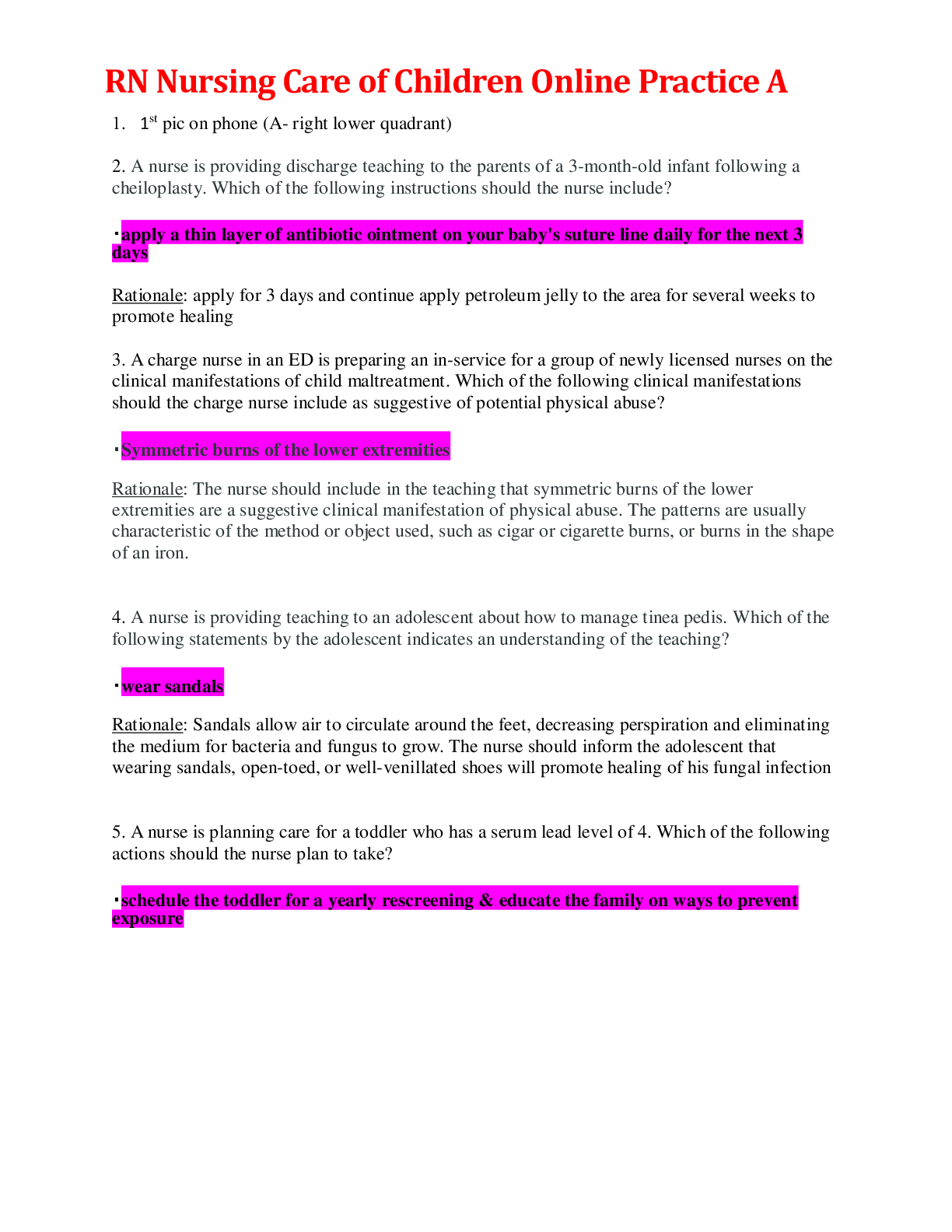
Reviews( 0 )
Document information
Connected school, study & course
About the document
Uploaded On
Jun 09, 2021
Number of pages
18
Written in
Additional information
This document has been written for:
Uploaded
Jun 09, 2021
Downloads
0
Views
42

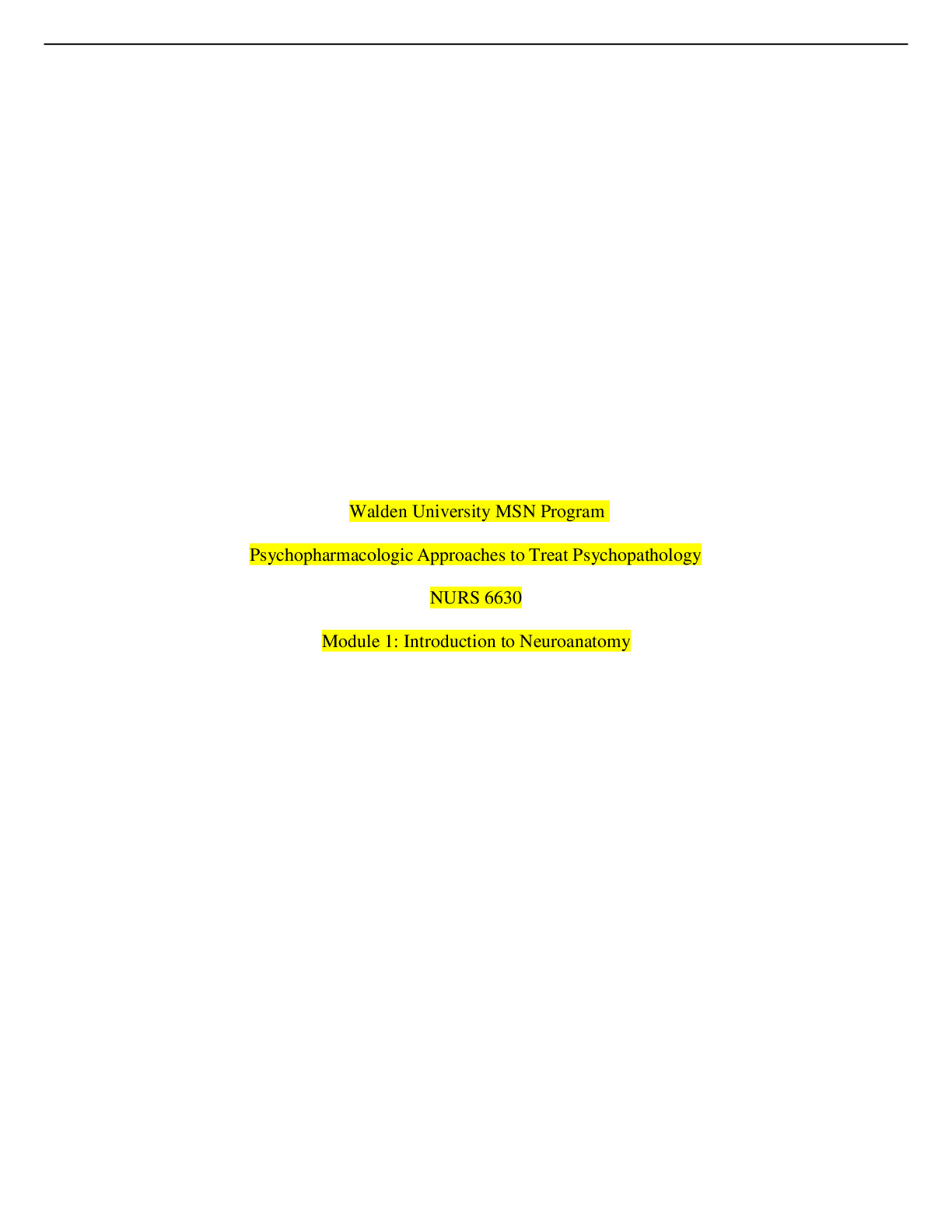





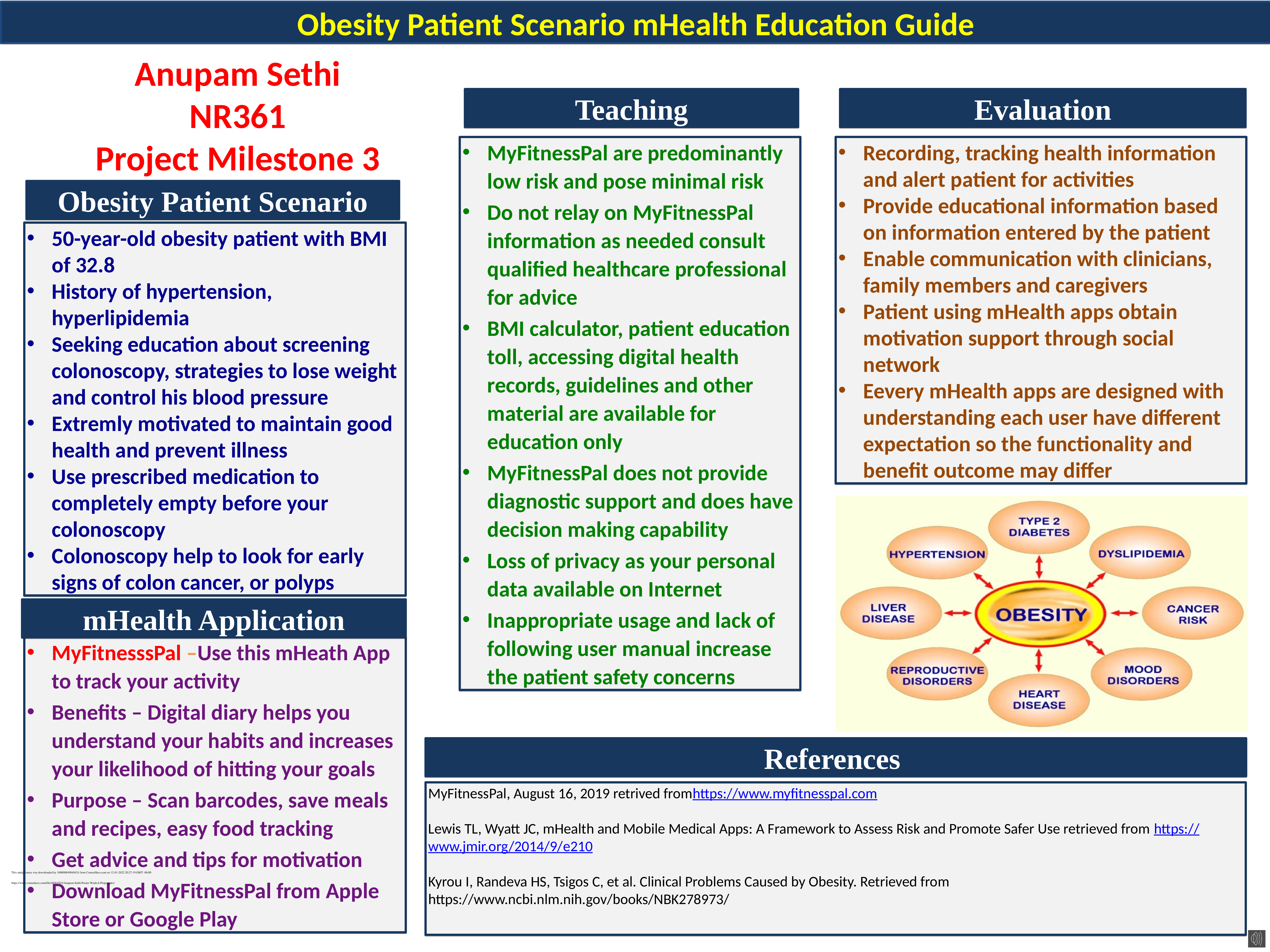



.png)
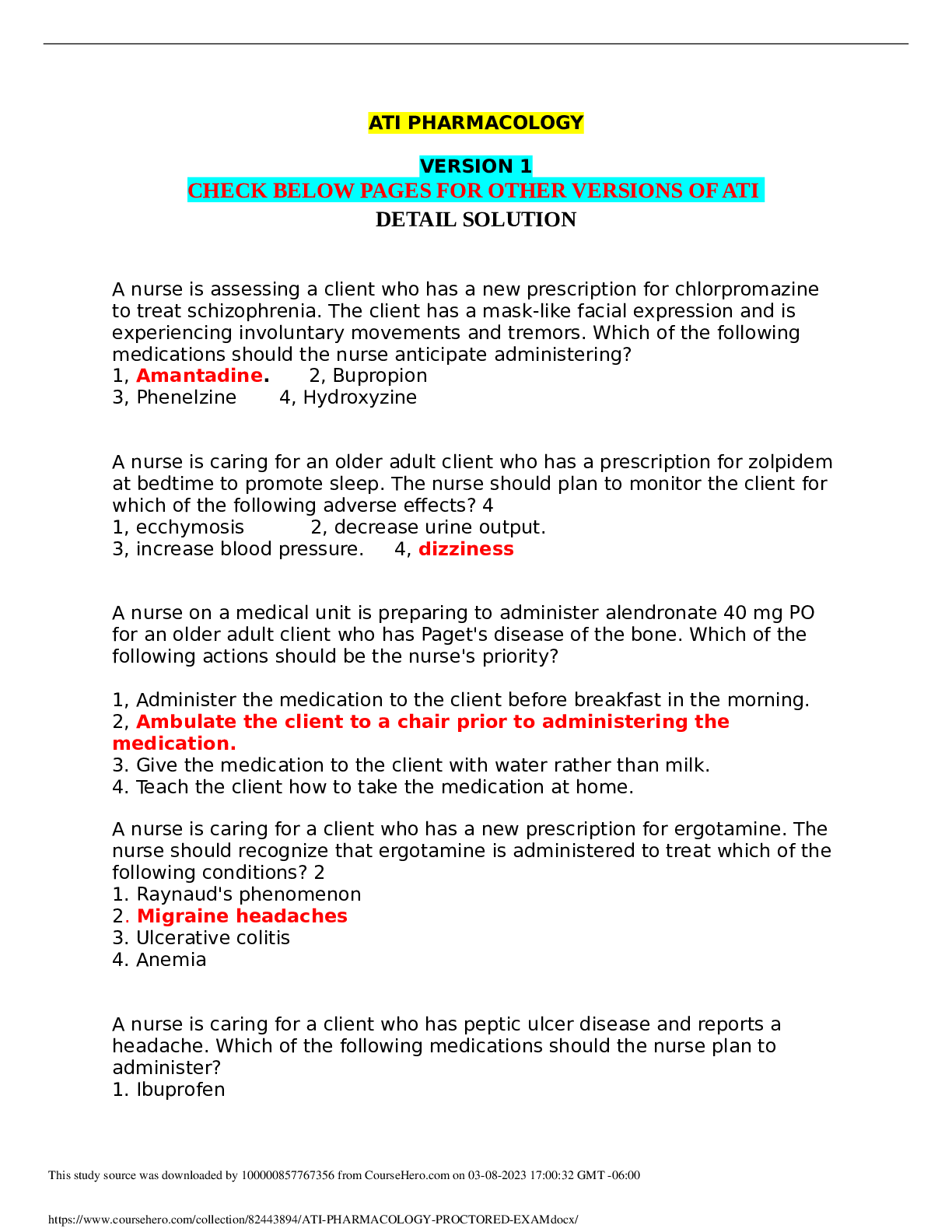
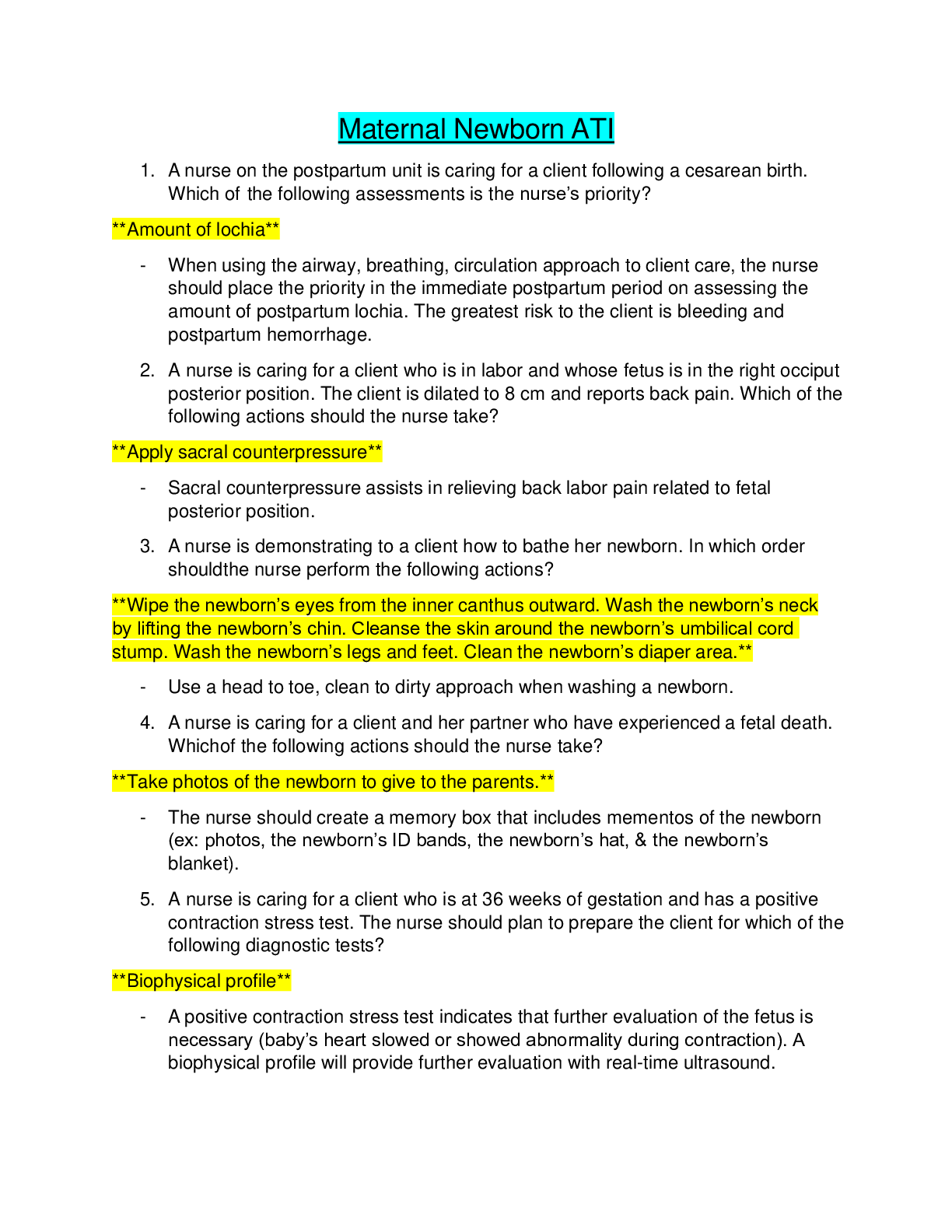



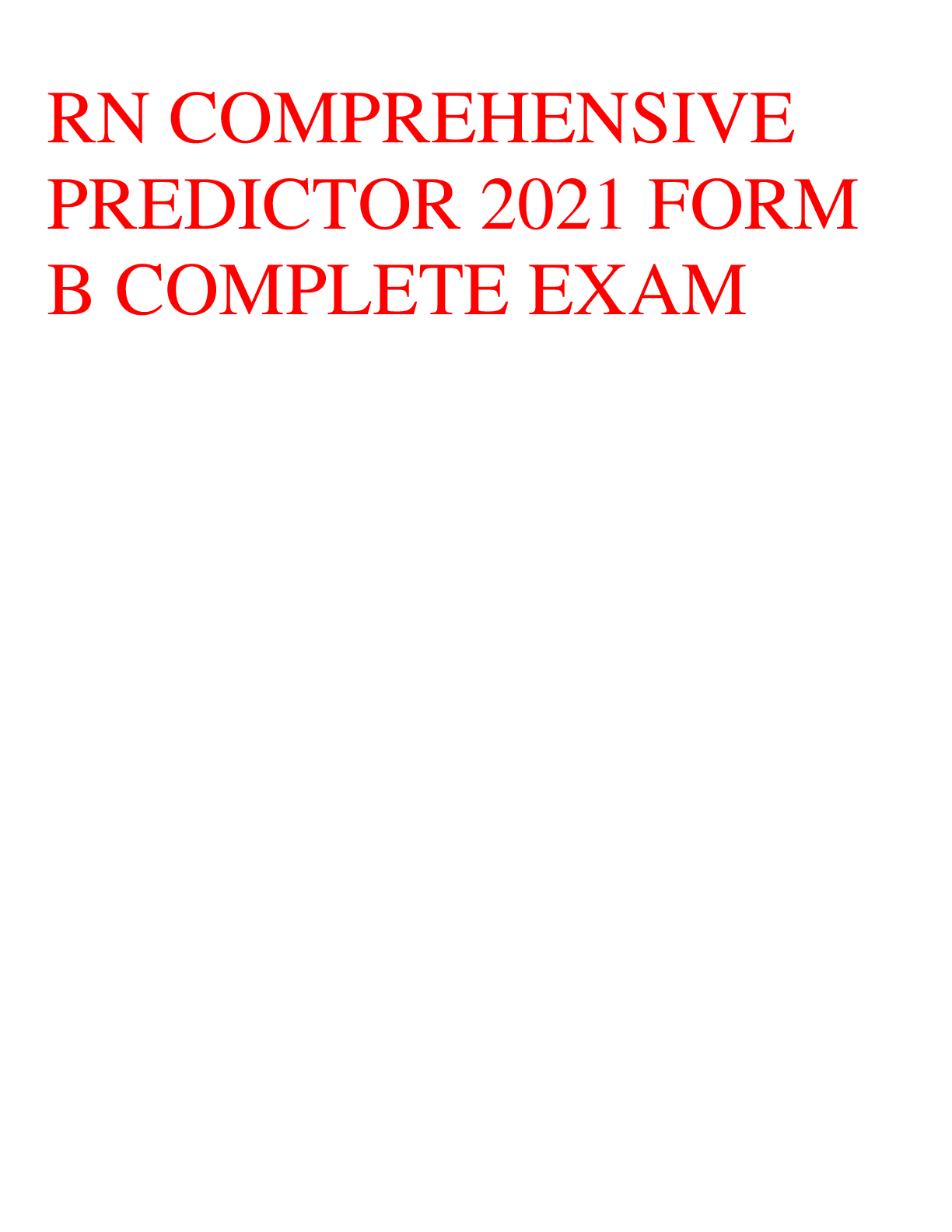

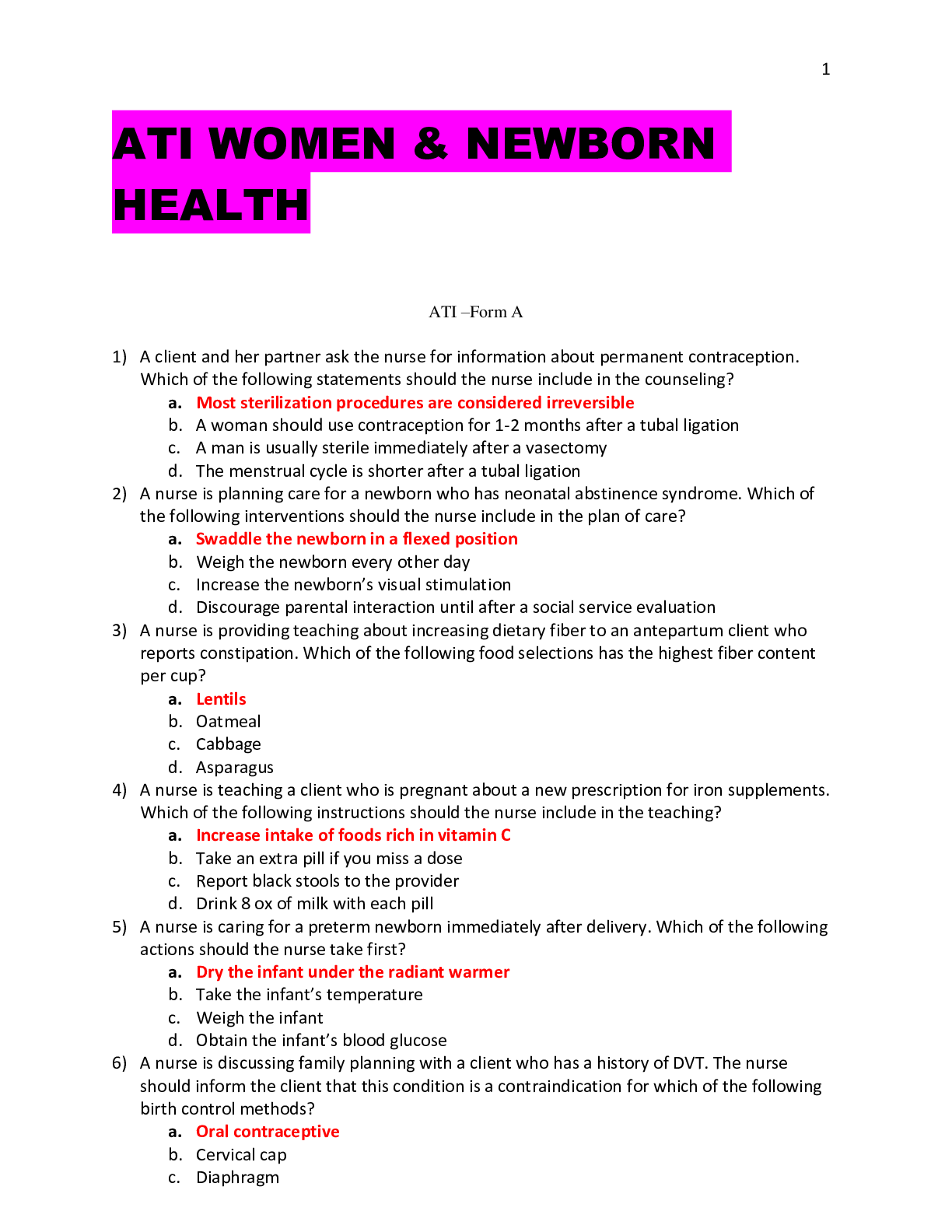

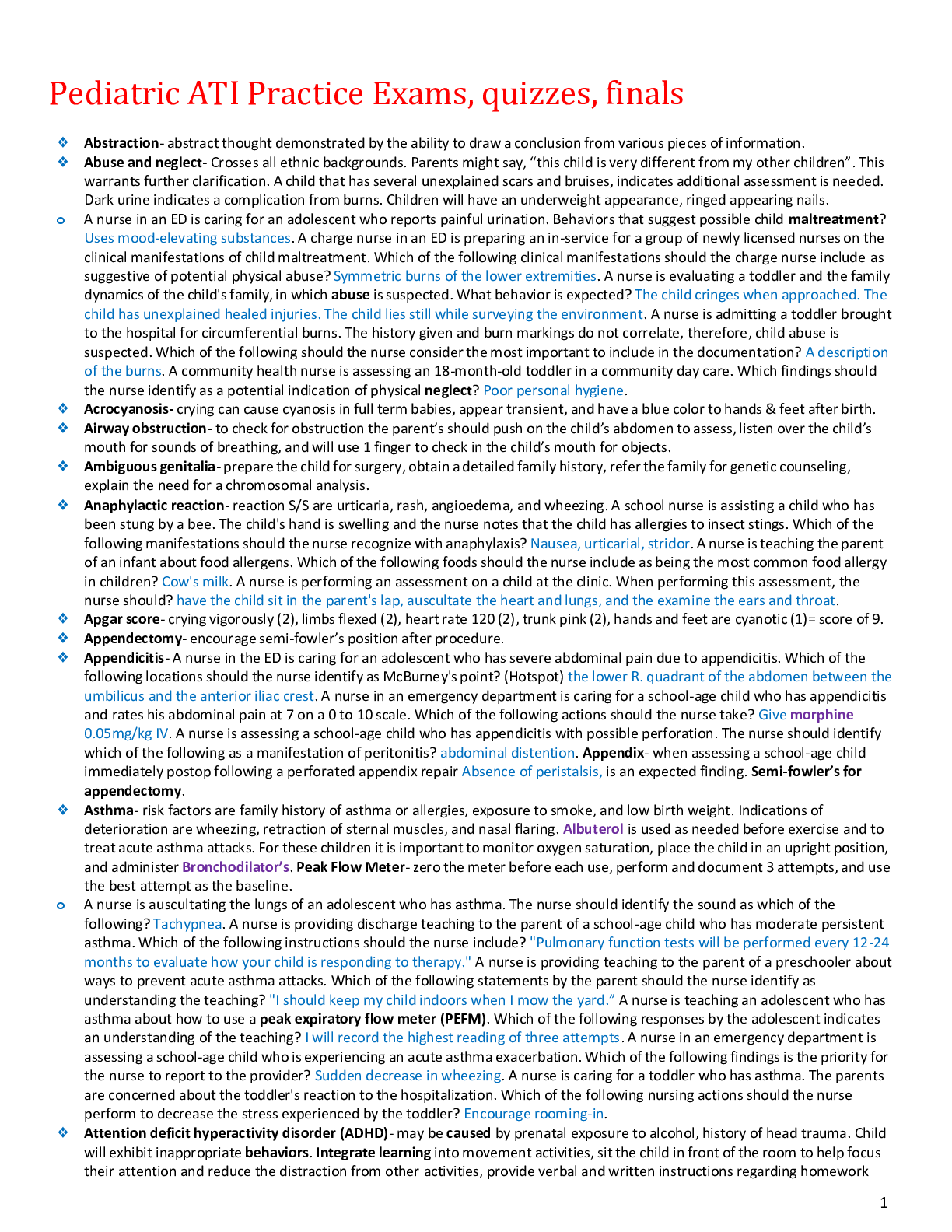

 (1).png)
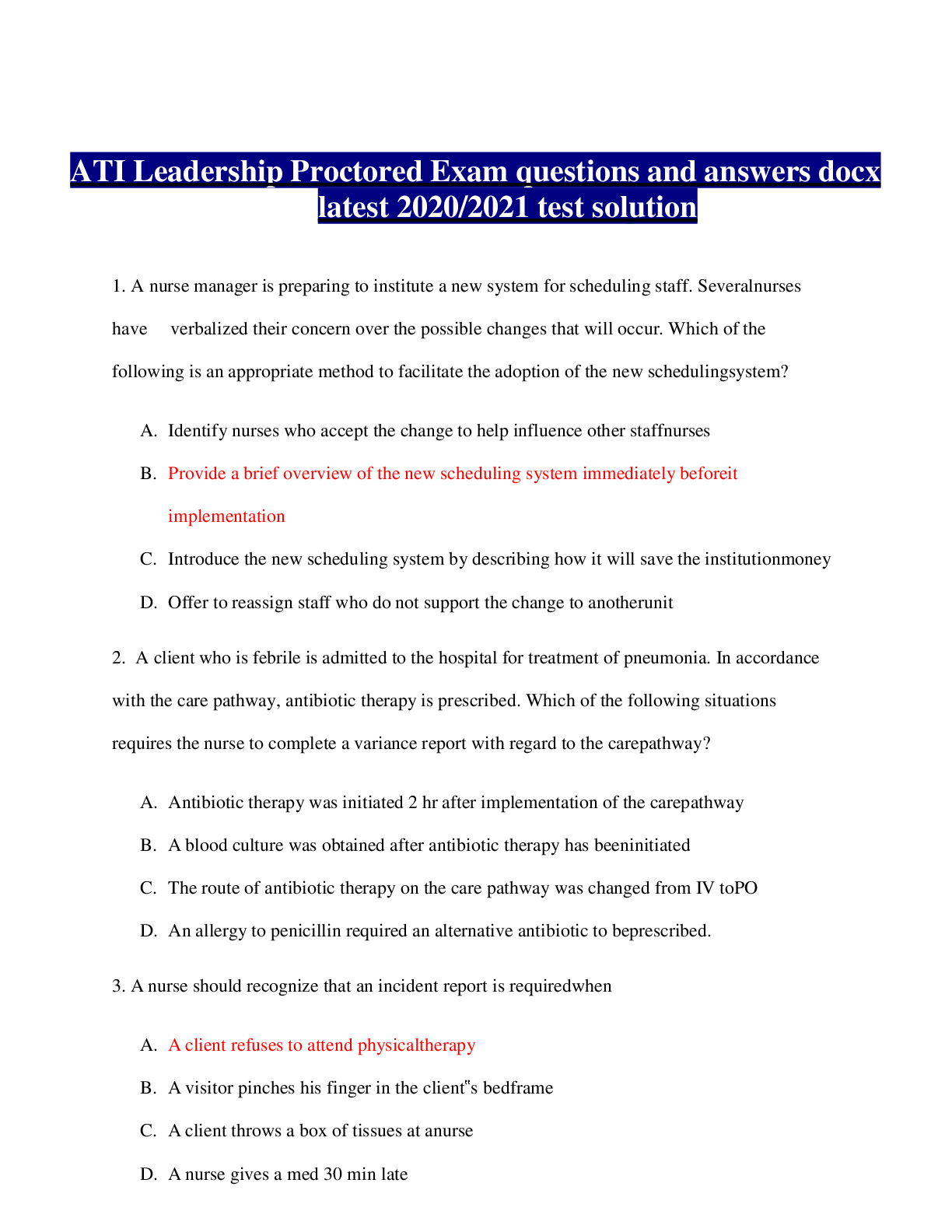

.png)

